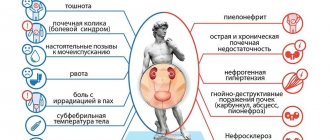Over the past few decades, the number of cases diagnosed with bronchial cancer has increased several times. In this pathological process, neoplasms are formed from the integumentary epithelium and bronchial glands, which are malignant in nature.
In which bronchi do malignant tumors occur?
The bronchi are the airways through which air penetrates deep into the lungs to saturate the blood with oxygen and clear it of carbon dioxide.
The bronchi are compared to a tree, when smaller branches are separated from a large trunk, which are split into even smaller ones... and so on until the smallest ones.
A malignant tumor of the bronchi in two out of three cases develops in large (main, lobar and segmental) bronchi.
Stages of development of the disease
Symptoms of cancer depend on the stage of its development:
- first. There are no metastases, the tumor is up to 3 cm in diameter, most often located in the segmental bronchi;
- second. Metastases are found in regional lymph nodes, the tumor is no more than 6 cm in diameter;
- third. The tumor is larger than 6 cm, cancer symptoms begin to manifest themselves acutely, metastases are detected in the lymph nodes;
- fourth. Metastases appear in vital organs, all symptoms clearly manifest themselves, which reduces the quality of life of patients.
Species and types
RB is divided into non-small cell and small cell cancer depending on the type of cells from which malignant transformation began.
Non-small cell bronchial cancer usually starts in flat, thin cells lining the inside of the bronchial tubes. This type of cancer is called squamous cell carcinoma .
Large cell adenocarcinoma , another type of non-small cell cancer, is much less common in the bronchi. It begins in the glandular cells on the outside of the lung. There are also several rare types of non-small cell bronchial cancer. These include sarcoma and sarcomatoid cancer.
Small cell cancer usually starts in the cells that line the large bronchi in the center of the lungs. The main types of small cell bronchial cancer are small cell carcinoma and combined small cell carcinoma (mixed tumor with squamous or glandular cells).
Types of cough
There are several types of cough, which characterizes a disease such as lung cancer. Let’s take a closer look at what kind of cough occurs with lung cancer:
- A short cough is a special type of cough accompanied by a strong, rapid contraction of the abdominal muscles. With such a cough, internal pressure on the respiratory tract increases and the trachea decreases.
- A short cough is repeated regularly. Its speed is equal to the speed of light. This type of cough is an early symptom of cancer.
Stages
Stages of small cell bronchial cancer
Small cell RB is divided into 2 stages - limited and extensive.
Limited-stage small cell RB is found on only one side of the chest. This may include cancer that is found in part of one lung and may have spread to the lymph nodes on the same side as the tumor. This may also include the lymph nodes in the center of the chest (mediastinum). Limited-stage small cell RB can be treated with radiation to one area of the body.
Extensive small cell disease has spread widely in the lung along with the tumor, to another lung, to the lymph nodes on the other side of the breast from the tumor, or to other parts of the body. Most people with small cell RB are diagnosed with advanced stage cancer because this type of tumor spreads early and quickly. And often before the first symptoms appear.
Small cell RB can be staged using the TNM system. Each stage is assigned a number from 1 to 4. Stages 1 to 4 are usually designated by the Roman numerals I, II, III and IV. Generally, the higher the number, the more widespread the cancer. However, the TNM system is used very rarely in this case.
Stages of non-small cell bronchial cancer
Prognostic groups for this type consist of 4 stages, followed by division into subtypes. These stages have important therapeutic and prognostic implications.
The grouping stages based on the TNM system are as follows:
- Stage 0 - TisN0M0
- Stage IA1- T1miN0M0 / T1aN0M0
- Stage IA2 - T1bN0M0
- Stage IA3 - T1cN0M0
- Stage IB - T2aN0M0
- Stage IIA - T2bN0M0
- Stage IIB - T1aN1M0 / T1bN1M0 / T1cN1M0 / T2aN1M0 / T2bN1M0 / T3N0M0
- Stage IIIA - T1aN2M0 / T1bN2M0 / T1cN2M0 / T2aN2M0 / T2bN2M0 / T3N1M0 / T4N0M0 / T4N1M0
- Stage IIIB - T1aN3M0 / T1bN3M0 / T1cN3M0 / T2aN3M0 / T2bN3M0 / T3N2M0 / T4N2M0
- Stage IIIC - T3N3M0 / T4N3M0
- Stage IVA - any T, any N, M1a or M1b
- Stage IVB - Any T, any N, M1c
- M1a indicates metastasis to the chest cavity
- M1b denotes one extrathoracic metastasis
- M1c denotes multiple extrathoracic metastases
Forecast
Bronchial cancer is one of the most unfavorable oncological diseases with high mortality. It is diagnosed late, so most patients die within the first year after diagnosis.
Small cell carcinoma has the worst prognosis. The five-year survival rate for this disease is 6%. Even when bronchial cancer is detected at a localized stage, the five-year survival rate is only 29%.
The prognosis for non-small cell cancer is slightly better. When detected in a localized stage, the five-year survival rate is 60%. But the disease is rarely detected on time. Therefore, the overall 5-year survival rate for all stages of non-small cell cancer is 23%.
Causes
There is strong evidence that the following factors increase the risk of developing RB.
Smoking tobacco
Smoking tobacco, especially cigarettes, is becoming the main cause of RD. There are many chemicals in tobacco smoke. Some of these chemicals are carcinogenic, meaning they cause changes in lung cells that can lead to the development of bronchial cancer.
About 72% of RD cases worldwide are associated with tobacco smoking. Your risk of developing bronchial cancer increases depending on how much you smoked, how old you were when you started smoking, and the number of cigarettes you smoke each day. The risk is also higher if you smoke tobacco and have other risk factors.
Radon
Radon is a colorless, odorless, tasteless gas that is formed by the natural breakdown of uranium in rocks and soil. Outdoors, radon gas is diluted by fresh air, so this is usually not a problem. But radon can enter buildings through floors or cracks in foundations. It can reach unsafe levels in closed, poorly ventilated areas. Inhaling radon gas can damage the cells that line the lungs.
Exposure to radon increases the risk of developing RB. Radon is the leading cause of bronchial cancer in non-smokers and the second leading cause in smokers.
Asbestos
Asbestos is widely used in building materials and many industries.
Research shows that smokers who are exposed to asbestos have an even greater risk of developing RB.
Occupational exposure to certain chemicals
Some chemicals are carcinogenic - they cause cancer. These chemicals can cause rash in people who are exposed to them at work. In general, the risk of developing RD is even higher in smokers who are exposed to these chemicals.
Occupational exposure to the following chemicals increases the risk of developing bronchial cancer:
- arsenic and inorganic arsenic compounds;
- beryllium and beryllium compounds;
- cadmium and cadmium compounds;
- chemicals used in rubber production, iron and steel casting;
- chloromethyl ethers and bis(chloromethyl) ether;
- chromium(VI) compounds;
- diesel engine exhaust;
- radioactive ores such as uranium and plutonium;
- silica dust and crystalline silica;
- some nickel compounds;
- some types of polycyclic aromatic hydrocarbons (PAHs);
- bitumen used in roofing;
- tungsten cobalt carbide;
- welding gases.
Some industries use many chemicals, making it difficult for researchers to understand which ones increase the risk of developing RD. People who work in the following industries have the highest risk of developing RD:
- rubber production;
- iron foundry;
- coal gasification;
- coke production;
- chimney sweep;
- commercial painting;
- roofing and paving slabs;
- industries that use the Acheson process to create silicon carbide.
Lung diseases
Certain lung diseases or conditions can damage the lungs and increase the risk of developing RP. Examples of these diseases:
- chronic obstructive pulmonary disease (COPD), which is long-term damage to the lungs often caused by smoking;
- tuberculosis (TB);
- lung infection caused by Chlamydophila pneumoniae.
Exposure to radiation
People who have had radiation therapy to the chest for certain types of cancer, such as Hodgkin lymphoma or breast cancer, have a higher risk of developing RB. These people have an even higher risk if they smoke.
Pollutants from cooking and heating
Indoor coal combustion for cooking and heating is most strongly associated with RB. Burning wood and other fuels such as manure or grass, and frying food in oil at high temperatures can also increase the risk of developing RB.
Weakened immune system
HIV infection and AIDS can weaken the immune system. People with HIV/AIDS have a higher risk of developing many types of cancer, including BC.
People who have an organ transplant take medications to suppress the immune system. A suppressed immune system increases the risk of developing RB.
Systemic lupus erythematosus
Lupus can affect various parts of the body and cause inflammation of the skin, joints, blood vessels, nervous system, and internal organs such as the heart, lungs, and kidneys. People with lupus have a higher risk of developing RB.
Beta-carotene supplements in smokers
Beta-carotene is a type of antioxidant. Some clinical trials showed that people who smoked more than 1 pack per day and were given high doses of beta-carotene had a greater risk of developing bronchial cancer.
Reasons for development
The reasons for the development of bronchogenic cancer are completely unknown. But scientists agree that the main factor that leads to this problem is smoking. If a person smokes more than 2 packs of cigarettes per day, the risk of getting cancer increases 25 times. Long-term inhalation of tobacco smoke leads to metaplasia of the epithelium of the respiratory tract mucosa.
Smoking is the main cause of bronchial cancer
Smoking increases the secretion of mucus, in which various harmful particles accumulate, producing an irritating effect. Under such conditions, the ciliated epithelium of the bronchi is not able to perform its assigned functions, which leads to the development of pathological processes.
Bronchopulmonary cancer develops in people exposed to long-term negative effects of chemical agents (mercury, arsenic, chromium and others). It is often diagnosed in people with chronic diseases of the respiratory system - bronchitis, tuberculosis, bronchiectasis.
Symptoms
In the early stages, bronchial cancer may not cause symptoms. Signs of bronchial cancer often appear as the tumor grows and cause changes in the body, such as coughing or shortness of breath. Other diseases can cause the same symptoms as bronchial cancer.
Signs and symptoms are the same for small cell and non-small cell RB:
- cough that gets worse or doesn't go away;
- shortness of breath;
- wheezing;
- blood in mucus coughed from the lungs
- chest infections, such as bronchitis or pneumonia, that don't go away or keep coming back;
- weight loss;
- fatigue;
- hoarseness or other voice changes;
- difficulty swallowing;
- larger than normal lymph nodes in the neck or above the collarbone;
- bone pain;
- headache.
Bronchial cancer: 4 stages. How long do you have left to live?
In order to determine the prevalence of cancer cells, the presence or absence of metastasis and the degree of damage to target organs, it has been proposed to determine the stage of cancer.
- At the first stage, the carcinoma is located within the bronchus. Survival rate is 68-92%.
- The second stage is characterized by the appearance of the first metastases in the regional lymph nodes. Survival rate is 53-60%.
- The third stage - the tumor grows into neighboring bronchi and affects several lobes of the lung. Survival rate – 13-24%.
- Stage four – the tumor extends beyond the lung and spreads to other organs. Survival rate is less than 1%.
Diagnostic methods
A chest x-ray is often the first imaging test used to diagnose bronchial cancer. This may show any spots, tumors or changes in the bronchi.
Bronchoscopy is used to look inside the large airways of the lungs (trachea and bronchi) for tumors or blockages. Special bronchoscopes with an ultrasound probe (endobronchial ultrasound or EBUS) can biopsy lymph nodes near the trachea and bronchi for diagnosis or detection of lymph node spread.
Magnetic resonance imaging (MRI) uses powerful magnetic forces and radiofrequency waves to create cross-sectional images of organs, tissue, bones and blood vessels. The computer turns the images into three-dimensional images.
Positron emission tomography (PET) uses radioactive materials called radiopharmaceuticals to look for changes in the metabolic activity of body tissues. A computer analyzes the radioactive samples and produces three-dimensional color images of the area being scanned.
PET scans are used to determine how far the disease has spread. The method can find tumors larger than 8 mm. It is more accurate than a CT scan for detecting spread to the lymph nodes in the middle of the chest (mediastinum) and other areas of the body.
Symptoms and signs of bronchopulmonary cancer
The central tumor shows its first signs in the form of a dry cough; in 40% of cases, sputum mixed with blood is observed over time. The development of pneumonitis with periodic symptoms is often observed, which patients often confuse with ARVI or influenza. Over time, the cough becomes productive, pain appears in the chest area, and body temperature increases. As the tumor grows, symptoms of bronchial cancer manifest themselves in swelling of the face and neck, their cyanosis, inability to lie down, and difficulty breathing. Metastases reach the liver, bones and brain, and hydrothorax is observed.
Note! Often, a person with signs of cancerous pathology of the bronchi begins to use antiviral drugs, which do not cure the disease, but help to intensify its manifestation.
Peripheral neoplasm does not show symptoms. This pathology is usually found randomly during an X-ray examination. When a cancerous tumor of the lungs and bronchi grows, symptoms manifest themselves in the form of pain, severe coughing and inflammation due to its spread into organ tissue. The last stage of development of an oncological neoplasm is characterized by the appearance of pneumonia and pleurisy.
Treatment of bronchial cancer in Belgium
The type of treatment for bronchopulmonary cancer may depend on the type of cancer and whether the disease has metastasized to distant organs.
Small cell bronchial cancer - treatment:
- chemotherapy;
- immunotherapy;
- laser therapy;
- radiation therapy;
- surgery.
Non-small cell bronchopulmonary cancer - treatment:
- surgery;
- chemotherapy;
- cryotherapy;
- immunotherapy;
- laser therapy;
- photodynamic therapy;
- radiation therapy;
- targeted therapy.
Surgery
This method is used for non-small cell forms and in some cases allows the tumor to be completely removed.
Wedge or segmental resection removes the bronchial tumor along with a margin of healthy tissue around the tumor.
A lobectomy removes the lobe of the lung that has a bronchial tumor. A bilobectomy is a type of lobectomy in which 2 of the 3 lobes of the right lung are removed.
A pneumonectomy removes the entire lung.
Extended pulmonary resection removes muscle, nerves, blood vessels and other tissue near the lungs to remove as much of the tumor as possible.
A chest wall resection removes muscle, bone, and other tissue from the chest wall.
Chemotherapy
Chemotherapy is used in three main ways:
- Neoadjuvant or primary systemic chemotherapy for bronchial cancer can be used before surgery to destroy cancer cells. It also allows the oncologist to determine the effect of a particular treatment regimen on the tumor.
- Adjuvant chemotherapy is a type of bronchial cancer treatment used after surgery or radiation to kill cancer cells that were not removed during surgery.
Main agents for chemotherapy:
- cisplatin and etoposide (Vepesid, VP-16);
- carboplatin (paraplatin, paraplatin AQ) and etoposide.
Immunotherapy
Checkpoint inhibitors are a form of immunotherapy that blocks signaling proteins that allow cancer cells to hide from the immune system.
Most often, depending on the type and stage of cancer, the following are used:
- Pembrolizumab (Keytruda®)
- Atezolizumab (Tecentriq®)
- Durvalmab (Imfinzi®)
- Gefitinib (Iressa®)
Targeted therapy
Targeted therapy options in cancer centers in Belgium (first, second or subsequent line) include:
- Osimertinib (Tagrisso®)
- Erlotinib (Tarceva®)
- Afatinib (Gilotrif®)
- Dacomitinib (Vizimpro®)
Radiation therapy
Belgian oncology clinics offer two main types of radiotherapy for RB:
- External beam radiation therapy (EBRT) delivers large doses of radiation to lung cancer cells from the outside using a variety of machine technologies.
- High dose rate (HDR) brachytherapy (internal radiation) delivers large doses of radiation from implants located near or inside a tumor in the body.
Bronchial cancer: symptoms, first signs of bronchial cancer, bronchial oncology, diagnosis and treatment
“Bronchi cancer” is a term that is rarely used by doctors. In medicine, the more common concept is “bronchopulmonary cancer,” which combines malignant tumors of the lungs and bronchi. This approach to terminology arose due to the fact that the lung tissue and the bronchial tree are closely related, both in an anatomical and functional sense.
Some figures and facts regarding bronchial cancer:
- The disease most often occurs in older people. In more than half of cases, bronchial cancer is diagnosed after the age of 50 years. Another 25% of cases occur in the age group of 40–50 years.
- The main cause of malignant tumors of the bronchi is smoking. Up to 80% of patients are smokers.
- Most often, the tumor occurs in the upper parts of the bronchial tree, since they are better ventilated, and carcinogens contained in the inhaled air are more likely to lead to malignant transformation of cells.
In which bronchi do malignant tumors occur?
The air that a person inhales passes through the nose, pharynx, larynx, and trachea. At the level of the upper edge of the fifth thoracic vertebra, the trachea ends and divides into two main bronchi . This location is called the tracheal bifurcation .
The main bronchi are the first order bronchi , they are divided into lobar (second order) , then into segmental (third order), subsegmental (fourth order), lobular, and finally into terminal (end) bronchioles.
All these branches together make up
the bronchial tree . The walls of large and small bronchi are structured in the same way: on the inside they are lined with mucous membrane , under it there is a framework - fibrocartilaginous membrane , on the outside - the adventitial membrane.
Malignant tumors that originate from the mucous membrane are called cancer. They can occur in any part of the lung, but are most often found in the hilum - where the main bronchus enters the lung. In two thirds of cases, cancer develops in the bronchi of the first, second and third order.
Classification of bronchial cancer
The histological (based on the appearance of tumor cells under a microscope) classification of bronchopulmonary cancer includes four main types of tumors:
- Small cell cancer occurs mainly in smokers, is highly aggressive, spreads quickly and is difficult to treat. It accounts for about 12% of all cases of bronchopulmonary cancer.
- Squamous cell carcinoma , together with the next two types, combines into a group of non-small cell tumors , which account for more than 80% of all cases of lung cancer. The risk of developing squamous cell carcinoma is strongly associated with smoking.
- Adenocarcinoma is most common among women and nonsmokers. Unlike squamous cell carcinomas, adenocarcinomas are usually smaller in size and tend to grow in the peripheral parts of the lung. A separate subgroup of bronchoalveolar adenocarcinomas is distinguished.
- Large cell carcinoma consists of large, undifferentiated cells.
Depending on how much the tumor tissue has lost its normal features, poorly differentiated and highly differentiated tumors are distinguished. The first ones are more aggressive.
When choosing treatment, the location of the tumor foci is of great importance. Depending on this indicator, bronchopulmonary cancer is divided into two types:
- Central - the tumor is located in the bronchi of the 1st–3rd order (main lobar, segmental).
- Peripheral - the tumor is located in the smaller bronchi.
Stages of bronchial cancer
Bronchopulmonary cancer is divided into stages depending on how far the tumor has spread in the body. In this case, they are guided by the generally accepted TNM classification. The letters in it mean:
- T—size of the primary lesion, degree of invasion into adjacent tissues.
- N - damage to regional (close to the primary tumor) lymph nodes.
- M—presence of distant metastases.
Depending on these indicators, the stage of the tumor is determined, which is designated by Roman numerals I–IV.
Causes of bronchial cancer
A normal cell turns into a tumor cell when certain changes occur in its genes. It is impossible to say exactly why, in one case or another, genetic defects arose that led to malignant transformation. But there are known factors that significantly increase the risk of the disease. They are called risk factors .
The main risk factor for bronchopulmonary cancer is smoking.
The likelihood that a person will be diagnosed with a malignant tumor directly depends on the length of smoking, the daily number of cigarettes smoked, the age at which the person started smoking, and the brand of cigarettes (tobacco quality, carcinogen content). Not only active but also passive smoking is dangerous. If someone constantly smokes in an apartment, the risk of lung cancer is increased for all its residents.
Other risk factors:
- Occupational hazards: workers in mines, factories producing cement, glass and fiberglass.
- Contact with chemicals, some volatile substances, asbestos.
- Air pollution with radon , a radioactive gas that is naturally released from the soil when uranium decays.
- It can accumulate indoors.
Symptoms of bronchial cancer
In the early stages, there are most often no symptoms. The tumor is diagnosed accidentally during an x-ray. Regular fluorography helps in early diagnosis.
Experts from the American Cancer Society recommend that long-term smokers consider regular CT scans.
Such periodic studies designed to diagnose cancer in early, asymptomatic stages are called screening .
Possible symptoms of bronchopulmonary cancer:
- Persistent chronic cough.
- Sputum mixed with blood.
- Dyspnea.
- Chest pain.
Even when symptoms appear, it is not always possible to recognize a malignant tumor immediately. The picture may resemble sluggish pneumonia, pleurisy, or another disease. It is important to be attentive to your health. If you experience any unusual symptoms, if they persist long enough, you should contact your doctor and get tested.
Make an appointment for a consultation around the clock +78 800 100 14 98
What is paraneoplastic syndrome in bronchopulmonary cancer?
Cancer cells produce various substances that enter the bloodstream and can cause pathological changes in the body.
This leads to the so-called paraneoplastic syndrome . In lung and bronchial cancer, the tumor often affects the nervous system.
This manifests itself in the form of disturbances in gait, balance, coordination of movements, swallowing, speech, memory, vision, sleep, etc.
Methods for diagnosing bronchial cancer
Usually the tumor is detected using x-rays. CT and MRI help to clarify its size, location, number of foci and their degree of invasion into surrounding tissues.
Bronchoscopy is used - an endoscopic examination, during which a special instrument in the form of a long flexible hose - a bronchoscope - is inserted into the bronchial tree and the mucous membrane is examined.
During bronchoscopy, a biopsy can be performed: a fragment of a pathologically changed area of the mucous membrane can be obtained and sent to the laboratory for cytological and histological examination.
A biopsy can be performed in other ways: using a needle inserted into the lung through the chest wall, during thoracoscopy, or thoracentesis. You can also do a cytological examination of the sputum to look for cancer cells.
PET scanning helps detect small metastases. During this study, sugar with a special radioactive label is introduced into the body. The radiopharmaceutical accumulates in tumor cells and makes the lesions visible in pictures taken using a special device.
If necessary, the doctor may prescribe other diagnostic methods.
Treatment of bronchial cancer
When choosing treatment for bronchial cancer, the doctor must take into account many factors: the stage and type of tumor, its location in the lung, the presence of damage to regional lymph nodes and distant metastases, age, health status of the patient, and concomitant diseases.
Surgical treatment of bronchopulmonary cancer
Surgical tumor removal is often the main treatment for local bronchial and lung cancer when there are no isolated metastases. The goal of radical surgery is to completely remove the tumor tissue. Depending on the size and location of the lesions, different types of surgical interventions are used:
- Removal of the entire lung - pneumonectomy .
- Removal of a lobe of the lung - lobectomy .
- Removal of a segment of the lung - segmental resection .
- Removal of the tumor with some surrounding healthy tissue - wedge resection .
- Removal of affected lymph nodes - dissection, lymphadenectomy .
The operation can be performed openly (through an incision) or endoscopically ( video-assisted thoracoscopic surgery , or VATS ).
Targeted therapy and immunotherapy
Targeted therapy and immunotherapy are modern, youngest trends in cancer treatment, the emergence of which became possible thanks to the rapid development of molecular genetics in recent decades:
- Targeted drugs affect a specific target molecule that cancer cells use for survival, uncontrolled reproduction, and activation of blood vessel growth. They act more targeted and selective compared to classical chemotherapy drugs, and due to this they are safer, but still have some side effects.
- The most commonly used immunotherapy drugs checkpoint —molecules that cancer cells use to suppress the immune system.
Typically these treatments are used in later stages when there are metastases. Also, in the later stages, doctors have to deal with such a complication of bronchial and lung cancer as pleurisy.
Survival prognosis
It is estimated that around 1 in 14 European men will develop bronchial cancer in their lifetime, and one in 16 will die from it.
It is estimated that approximately 1 in 15 European women will develop bronchial cancer during their lifetime, and one in 19 will die from it.
Between 2012 and 2014 in the EU as a whole, regardless of type and stage at initial diagnosis, the overall five-year survival rate was 15% for men and 22% for women.
Find out more about bronchial cancer and its treatment in Belgium. Write to us or request a call back.
Radiation therapy
This treatment is based on exposure of tumor tissue to radioactive radiation. In the vast majority of cases, such procedures are performed before or after surgery, which makes it possible to reduce the size of the tumor. However, in some cases, chemotherapy becomes the main and only treatment for bronchial cancer. What are these cases?
- Refusal of the operation.
- Inoperable case.
- General serious condition of a cancer patient.
If such factors are present, doctors decide to use radiation for 6-7 weeks. The total dose can reach 70 gray. The disadvantage of this treatment option is severe side effects (pain, nausea and vomiting, dizziness). An alternative has become a cyberknife - a narrow directed beam of radiation that effectively replaces a surgeon’s scalpel.
Complication
In the presence of bronchial cancer, complications develop. They can be divided into groups:
- Inflammation. These include lung abscess and pneumonia.
- Mechanical complications. This is obstruction of the SVC, prolapse of a segment or lobe of the lung.
- Pleural complications. They are caused by the spread of metastases to the pleural tissues or by direct damage to them.
- Cardiac complications. They occur when a tumor grows into the heart area. Arrhythmia develops and/or accumulation of fluid mixed with blood begins in the pericardial cavity.
- Metabolic disorders. They are rare and develop mainly only in later stages.
- Neurological complications. This is a lesion of the laryngeal and phrenic nerves, sympathetic ganglia, and brachial plexuses.
- Brain tumor caused by metastases. Occurs in 20-25% of deaths. Manifested by severe headaches and mental disorders.
- Metastasis to any organ or part of the body. Most often, metastases appear in the lymph nodes and supraclavicular areas. They should be examined in patients suspected of having cancer. The liver and ribs are often affected.
Diagnostics
At the first stage, physical examination of patients with bronchial cancer provides little information. If atelectasis is present (setting of one lobe of the respiratory organ), retraction of the supraclavicular zone is observed and compliant areas of the chest wall are palpated.
When listening, there are various sound phenomena, including the absence of sounds of the respiratory process in the area of retraction of the lung lobe.
To clarify the picture, the specialist prescribes:
- X-ray;
- MRI and computer diagnostics of the respiratory system;
- bronchoscopy;
- endoscopic biopsy;
- water analysis for cytological research.
It is necessary to conduct an ultrasound of the pleura, mediastinum, and pericardium - this will reveal signs of tumor growth into other organs. If carcinomatous pleurisy has developed, thoracentesis (puncture of the sternum wall) is performed to take pleural fluid for cytological examination.
If necessary, ultrasound of the adrenal glands and liver, scintigraphy of skeletal bones, and biopsy of brain tissue are prescribed. When diagnosing bronchial cancer, it is necessary to separate this pathology from bronchial foreign bodies, adenoma, and chronic bronchitis.
Features of surgical treatment
Surgery is the only effective treatment for bronchial cancer. If the diagnostic results reveal that the tumor is inoperable, maintenance therapy is prescribed. It helps reduce the manifestation of the main symptoms of the disease, which improves the patient’s quality of life.
Types of surgical interventions
Lung surgery to remove a malignant tumor can be performed in several ways:
- circular resection of the bronchi. Performed when a malignant process is detected in the early stages of development;
- partial resection of the lung with removal of part of the organ;
- pneumonectomy. This involves complete removal of the lung, which is performed in extreme cases.
Features of the postoperative period
Surgery to remove a malignant tumor is considered a rather complex procedure that requires careful preparation and proper postoperative care. After surgery, doctors carefully monitor the patient’s condition and developing symptoms. On the first day, lung aspiration is performed through special drains.
After the operation, doctors closely monitor the patient's condition.
After surgical treatment of bronchial cancer, antibacterial therapy is indicated, which reduces the risk of various complications. Based on developing symptoms, patients may be prescribed other medications.
The patient must adhere to a strict diet throughout the postoperative recovery period. A return to the patient’s usual diet occurs only if his condition improves. To eliminate the symptoms of respiratory failure, special breathing exercises are prescribed.











